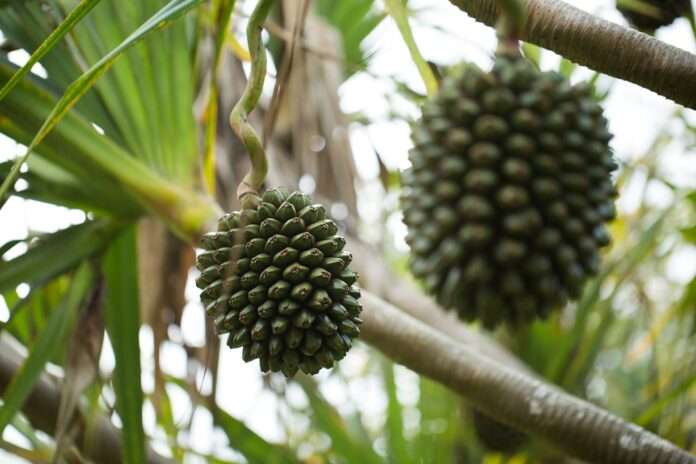The enchanting world of flora is adorned with countless unique and valuable plants, each offering its own distinct contributions to both nature and human society. One such remarkable gem is Kewra (Pandanus), commonly known as “Screw pine.” This fascinating tree, scientifically referred to as Pandanus sp., holds a special place in various cultures and ecosystems. In this comprehensive article, we delve into the intricate details of this remarkable plant, exploring its significance, utilization, cultural connections, and its struggle for survival in the modern world.

Table of Contents
Introduction to Pandanus: The Green Marvel
Pandanus, or “Screw pine,” is an exquisite tree that captivates with its lush green foliage, characterized by dichotomous branching and long, linear leaves reminiscent of pine needles. Native to tropical regions spanning from Asia to Australasia, the Pandanus tree graces the landscapes of numerous coastal and island areas. This handsome tree is not just a visual delight but also a vital component of the ecosystem, holding economic and cultural importance among the local communities.
Keystone Plant and Economic Livelihood
In the grand tapestry of nature, certain plants play pivotal roles in shaping their ecosystems – these are known as “Keystone Plants.” Pandanus proudly claims its position as a keystone plant, ranking alongside bamboos and reeds. Coastal and island communities have harnessed the plant’s various components for their minor economic needs, making it an integral part of their livelihoods.
Pandanus: An Economic and Cultural Pillar
The lush groves of Pandanus stand as vital “vegetation” along coasts and islands, intertwining with human settlements. The economic value of Pandanus stems from its fine natural fiber, recognized as one of the world’s best, used for crafting bedmats and other products. An essential oil, Kewra, is distilled from the male flowers of the fragrant Screw pine, adding flavor to a wide array of culinary delights across the tropical regions it calls home.
Exploring Kewra: Fragrant Essence of Pandanus
Kewra, also known as Keora or Kewda, emerges as a star from the heart of the Pandanus tree. This essential oil, derived from the male flowers, exudes a captivating fragrance that enhances the culinary experiences of millions. The Kewra tree stands tall in Southern India, Malaysia, Burma, Sri Lanka, Thailand, and Indonesia, offering its aromatic bounty to the world.
Pandanus as a Livelihood Source
The traditional wisdom of utilizing Pandanus extends to various cottage industries, such as coir and mat weaving. Coastal people in Kerala and beyond have intricately woven the leaves of Pandanus to craft mats and other items, supporting their economic sustenance. This practice has empowered women to take an active role, showcasing the resilient spirit of community engagement.
Pandanus as a Guardian of Coasts
The inherent ecological value of Pandanus is evident in its role as a guardian of coastal areas. Planted along water bodies and as living fences, Pandanus contributes to preventing soil erosion and safeguarding delicate ecosystems. This mutually beneficial relationship between the plant and its surroundings illustrates nature’s intricate balance.
Kewra: A Jewel in the World of Perfumery
The fragrant allure of Kewra extends beyond the culinary domain, making its mark in the world of perfumery. This versatile essence finds its way into perfumes, ayurvedic medicines, and various products. Its antibacterial properties and unique scent create a repulsive barrier against pests, showcasing the plant’s innate defenses.
Challenges Faced by Kewra Industry
While Kewra’s aromatic potential remains unparalleled, challenges plague its industry. Outdated technology, rising fuel costs, and dependency on distant traders have impacted the once-thriving Kewra distillation units. Despite its deep roots in the culture and economy, the industry now grapples with dwindling numbers and economic hardships.
Conservation Efforts and Sustainable Future
Preserving the legacy of Pandanus requires concerted efforts from all fronts. Re-establishing the resource link between communities and the plant is paramount, ensuring its sustained usage for economic and cultural purposes. Empowering self-help groups, implementing legal regulations, and raising awareness are all steps towards securing the future of Pandanus.
Conclusion: Pandanus – A Living Heritage
In the ever-evolving narrative of nature and humanity, Pandanus stands as a living heritage, a testament to the intricate relationship between people and the plant world. From its economic contributions to its role in cultural traditions, Pandanus embodies a harmony between nature and society that deserves our admiration and protection.



Nice And insight full article